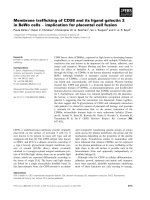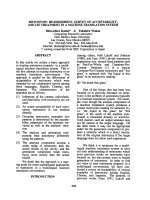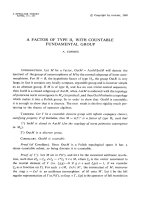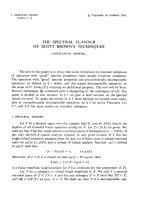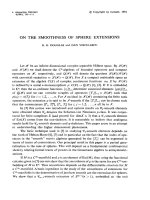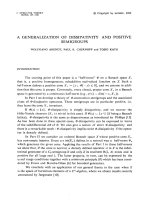Báo cáo toán học: "a matrix representation of graphs and its spectrum as a graph invariant" ppt
Bạn đang xem bản rút gọn của tài liệu. Xem và tải ngay bản đầy đủ của tài liệu tại đây (134.04 KB, 14 trang )
a matrix representation of graphs and its
spectrum as a graph invariant
David Emms
Department of Computer Science
University of York, York YO10 5DD, U.K.
Edwin R. Hancock
Department of Computer Science
University of York, York YO10 5DD, U.K.
Simone Severini
Department of Mathematics and Department of Computer Science
University of York, York YO10 5DD, U.K.
Richard C. Wilson
Department of Computer Science
University of York, York YO10 5DD, U.K.
Submitted: Nov 16, 2005; Accepted: Mar 16, 2006; Published: Apr 4, 2006
2000 Mathematics Subject Classification: 05E30, 05C60
Abstract
We use the line digraph construction to associate an orthogonal matrix with
each graph. From this orthogonal matrix, we derive two further matrices. The
spectrum of each of these three matrices is considered as a graph invariant. For the
first two cases, we compute the spectrum explicitly and show that it is determined
by the spectrum of the adjacency matrix of the original graph. We then show
by computation that the isomorphism classes of many known families of strongly
regular graphs (up to 64 vertices) are characterized by the spectrum of this matrix.
We conjecture that this is always the case for strongly regular graphs and we show
that the conjecture is not valid for general graphs. We verify that the smallest
regular graphs which are not distinguished with our method are on 14 vertices.
the electronic journal of combinatorics 13 (2006), #R34 1
1 Introduction
Graphs are often conveniently represented using matrices, for example, the adjacency
matrix, the Laplacian matrix, etc. [5]. Many important properties of a graph are encoded
in the eigenvalues of the matrix representation. However, eigenvalues generally fail to
separate isomorphism classes. In this paper, we consider some matrix representations
inspired by the notion of coined quantum walks [1]. Since strongly regular graphs give
rise to relatively large sets of non-isomorphic graphs which are cospectral with respect
to the commonly used matrix representations, we use these graphs as a testing ground
for the representations that we define. Let G be a graph and let U be the orthogonal
matrix inducing a coined quantum walk on G, where the coins are Grover matrices. For
every given k, we define a digraph, D,withanarc(i, j) if and only if U
k
i,j
> 0. For
k = 1, we express the adjacency eigenvalues of D in terms of the ones of G. When
considering strongly regular graphs, we describe how to construct directly D from G.For
strongly regular graphs, we conjecture that the eigenvalues of the adjacency matrix of D
distinguish G from its cospectral mates for k = 3. We verify this conjecture numerically
for all strongly regular graphs up to 64 vertices contained in the tables of Spence [14]
(the graphs srg(16, 9, 4, 6) were obtained from the tables of McKay [9]). By providing
counterexamples, we show that our method fails to distinguish general graphs. Hopefully
these counterexamples will help understanding what graphs are cospectral with respect
to the representations described here.
The remainder of the paper is organized as follows. In Section 2, we recall the defini-
tion of the orthogonal matrix U and give a formula for its eigenvalues. We define digraphs
derived from powers of U, and propose using these digraphs to distinguish the original
graph from its cospectral mates. In Section 3, we focus on strongly regular graphs. We
describe some structural properties of the digraph D obtained from U
3
.InSection4,we
list the sets of strongly regular graphs for which the eigenvalues of D successfully distin-
guish a graph from its cospectral mates. We conclude with counterexamples involving
general graphs.
Recently, dynamical processes based on quantum evolution have been considered for
attacking the graph isomorphism problem [6, 13]. In this context, Shiau et al. [13] gave
evidence that quantum walks alone are not successful. The setting they describe is as
follows. Let {|j :1≤ j ≤ n} be an orthonormal basis of a Hilbert space (|j is a ray
and i| is the linear functional which maps each |j to the usual inner product, which is
denoted by i|j). Given a graph G, let us define the Hamiltonian H = −
M(G)
a,b
c
†
a
c
b
,
where the operator c
†
a
c
b
is given by i|c
†
a
c
b
|j = δ
i,a
δ
b,j
and M(G) is the adjacency matrix
of G. The evolution for a time t of the initial states {|ψ
j
(0) = |j :1≤ j ≤ n} is
governed by the Schr¨odinger equation i
d|ψ
j
(0)
dt
= H|ψ
j
(0). In [13], it was shown that
the matrix whose entries are O
i,j
= ψ
i
(0)|ψ
j
(t) do not help in distinguishing pairs of
strongly regular graphs with the same set of parameters. However, by making use of some
techniques described in [11], it was also given an alternative method which distinguished
the electronic journal of combinatorics 13 (2006), #R34 2
numerically all known strongly regular graphs up to 29 vertices. It would be interesting
to investigate potential connections between [13] and the present paper.
2 Representing graphs with orthogonal matrices
Let G =(V,E) be a simple undirected graph (that is G is loopless and without multiple
edges). Let D
G
=(V, A) be the directed graph obtained from G by replacing every edge
{i, j}∈E(G) with the pair of arcs (i, j)and(j, i). The degree of a vertex i is denoted by
d(i). A graph is said to be k-regular if every of its vertices has degree k. Unless otherwise
stated, in this paper we will consider only graphs with minimum degree 3.
Definition 2.1 Given a graph G,wedenotebyU(G) the matrix defined as follows:
for all (i, j), (k, l) ∈ A(D
G
),
U(G)
(i,j),(k,l)
:=
2
d(j)
− δ
i,l
, if j = k;
0, otherwise.
The matrix U(G) induces a coined quantum walk on G, where the coins are Grover
matrices [1]. Here are some basic observations about U(G):
• If |E(G)| = m then U(G)is2m×2m and the vertices of degree zero do not contribute
to the dimension of U
G
.
• Given i ∈ V (G), if d(i)=1and{ i, j}∈E(G), then U(G)
(j,i),(i,j)
= 1, and this is
the unique non-zero entry in the row indexed by (j, i) and in the column indexed
by (i, j).
• Given j ∈ V (G), if d(j)=2and{i, j}, {j, k}∈E(G), then U(G)
(i,j),(j,i)
=
U(G)
(k,j),(j,k)
=0andU(G)
(i,j),(j,k)
= U(G)
(k,j),(j,i)
=1. So,ifG is 2-regular,
the matrix U(G) has exactly a one in every row and every column and it is then a
permutation matrix.
• Since G is undirected, U(G)
(i,j),(j,i)
=0andU(G)
(j,i),(i,j)
= 0 for every {i, j}∈
E(G). However, we have assumed that the minimum degree of G is 3, and then
U(G) is not symmetric. In fact, for three distinct vertices i, j, l ∈ V (G) such that
{i, j}, {j, l}∈E(G), we have U(G)
(i,j),(j,l)
= 0, but U(G)
(j,l),(i,j)
=0sincei = l.
The support of an n × n matrix M, denoted by M
,isthen × n (0, 1)-matrix with
elements defined as follows:
M
i,j
:=
1ifM
i,j
=0;
0 otherwise.
Let M(G) be the adjacency matrix of a graph (digraph) G.Theline digraph of a
digraph D, denoted by
−→
LD, is the digraph defined as follows: V (
−→
LD)=A(D)and
the electronic journal of combinatorics 13 (2006), #R34 3
((i, j), (k, l)) ∈ A(
−→
LD) if and only if j = k.Ifd(i) > 2 for every i ∈ V (G) then one can
verify that U(G)
= M(
−→
LD
G
) [12].
Graphs (or digraphs) G and H are isomorphic (written G
∼
=
H)ifthereisapermuta-
tion matrix P such that M(G)=PM(H)P
−1
,whereM(G)andM(H) are the adjacency
matrices of the graphs G and H, respectively. Harary and Norman [7] proved that if
D and F are digraphs without sources or sinks then
−→
LD
∼
=
−→
LF if and only if D
∼
=
F
(i ∈ V (D)isasource if there is no j such that (j, i) ∈ A(D); a sink if there is no j such
that (i, j) /∈ A(D)). Since D
G
is without sources or sinks, it follows that G
∼
=
H if and
only if U(G)
= QU(H)Q
−1
, for some permutation matrix Q. According to Definition 1,
this fact is sufficient to ensure that G
∼
=
H if and only if U(G)=QU(H)Q
−1
, for some
permutation matrix Q.Inwords,U(G) “faithfully” represents G.
The spectrum of a matrix M is the multiset of the eigenvalues of M, and is denoted
by Sp(M)={[λ
i
]
m
i
:1≤ i ≤ m},whereλ
1
,λ
2
, , λ
k
are the eigenvalues of M and
m
1
,m
2
, , m
k
their respective multiplicities. Let T (G) be the matrix with ij-th entry
T (G)
i,j
:=
1
d(j)
, if M(G)
i,j
=1;
0, otherwise.
We can obtain Sp(U(G)) from Sp(T (G)), as shown in the next result.
Proposition 2.2 Let G be a graph on n vertices and m edges. The matrix U(G) has 2n
eigenvalues of the form
λ = λ
T
± i
1 − λ
2
T
,
where λ
T
is an eigenvalue of the matrix T (G). The remaining 2(m − n) eigenvalues of
U(G) are ±1 with equal multiplicities.
Proof. Let M = M(G), U =(G)andT = T (G). Since G is undirected, we have
M
2
i,j
= M
i,j
M
j,i
= M
i,j
. By Definition 1,
U
(i,j),(k,l)
= M
i,j
M
k,l
δ
j,k
2
d(k)
− δ
i,l
.
Let u be an eigenvector of U with eigenvalue λ (notice that the entries of u have two
indices as it is for the rows and the columns of U). By making use of this equation, we
can write
λu
(i,j)
=
k,l
U
(i,j),(k,l)
u
(k,l)
=2
M
i,j
d(j)
l
M
j,l
u
(j,l)
− M
i,j
u
(j,i)
.
the electronic journal of combinatorics 13 (2006), #R34 4
Let t be an eigenvector of T with eigenvalue λ
T
. Define
u
(i,j)
=
M
i,j
t
j
d(j)
− λ
∗
M
i,j
t
i
d(i)
.
Then
2
M
i,j
d(j)
l
M
j,l
u
(j,l)
− M
i,j
u
(j,i)
=
M
i,j
t
j
d(j)
(2λ
T
− λ
∗
) − M
i,j
t
i
d(i)
.
Since U is real-orthogonal, its eigenvalues have magnitude 1. It follows that
λu
(i,j)
= λ
M
i,j
t
j
d
j
(2λ
∗
λ
T
− (λ
∗
)
2
) − λ
∗
M
i,j
t
i
d
i
.
Therefore, u is an eigenvector of U if 2λ
∗
λ
T
−(λ
∗
)
2
=1orλ+λ
∗
=2λ
T
(λ
∗
is the complex
conjugate of λ). It is easy to verify that the remaining eigenvalues are ±1.
Two graphs G and H are said to be cospectral (or isospectral), with respect to a given
matrix representation, if the spectra of the matrices representing the graphs are identical
(see, e.g., [16]). For example, let G and H such that
M(G)=
01100
10010
10010
01100
00000
and
M(H)=
00001
00001
00001
00001
11110
.
Then Sp(M(G)) = Sp(M(H)). The following corollary is a straightforward consequence
of Proposition 2.2.
Corollary 2.3 Given graphs G and H, Sp(U(G)) = Sp(U(H)) iff Sp(T (G)) = Sp(T(H)).
If G
∼
=
H then Sp(M(G)) = Sp(M(H)), but the converse is not necessarily true. This
is the case for the graphs G and H considered in the above example, since Sp(M(G)) =
Sp(M(H)) = {[−2]
1
, [0]
3
, [2]
2
} but, of course, G H. Also, Sp(T (G)) = Sp(T (H)) does
not imply that G
∼
=
H. For instance, if G is a k-regular graph then Sp(T (G)) = {[
1
k
λ
i
]
m
i
:
1 ≤ i ≤ k}, where Sp(M(G)) = {[λ
i
]
m
i
:1≤ i ≤ k}. So, for two k-regular graphs G
the electronic journal of combinatorics 13 (2006), #R34 5
and H, Sp(M(G)) = Sp(M(H)) if and only if Sp(T (G)) = Sp(T (H)), or, equivalently,
Sp(U(G)) = Sp(U(H)). Two non-isomorphic k-regular cospectral graphs G and H are
then not distinguished by the spectra of U(G)andU(H).
Now, let M and N be matrices such that Sp(M) = Sp(N)={[λ
i
]
m
i
:1≤ i ≤ n}.For
any natural number p, Sp(M
p
) = Sp(N
p
)={[λ
p
i
]
m
i
:1≤ i ≤ n}, but it is not necessarily
the case that Sp(M
p
) = Sp(N
p
). This is again the case of the graphs G and H in the
above example:
M(G)
2
=
10010
01100
01100
10010
00000
;
M(H)
2
=
11110
11110
11110
11110
00001
.
Sp(M(G)
2
)={[0]
3
, [2]
2
} and Sp(M(H)
2
)={[0]
3
, [1], [4]}. The entry M(G)
p
i,j
equals
the number of paths of length p between vertices i and j.NotethatM(G)
2
1,1
=2and
M(G)
2
1,1
=1. ThisimpliesthatmatrixM(G)
p
contains generally less information about
the structure of a graph G,sinceM(G)
p
i,j
= 1 if and only if the number of paths of
length p between vertices i and j is non-zero. Despite this fact, it is legitimate to ask
the following question: given graphs G and H such that Sp(M(G)) = Sp(M(H)) what
conditions imply that Sp(M(G)
p
) = Sp(M(H)
p
), for some p?IfagraphG with diameter
p is connected and non-bipartite then M(G)
p
= J,whereJ denotes the all-ones matrix.
As a consequence, if two graph G and H have diameter p then Sp(M(G)
q
) = Sp(M(H)
q
)
for every q ≥ p, even if Sp(M(G)) = Sp(M(H)). The spectra Sp(M(G)
q
) and Sp(M(H)
q
)
are indeed of no use in distinguishing G and H if these graphs have diameter 2.
Given a graph G, since the matrix U(G) is real-orthogonal, the support of U(G)
p
, for
some p, is presumably different from the support of M(
−→
LD
G
)
p
. This is because of the
contribution of the negative entries in U(G). On the basis of this observation, we define
the following matrix.
Definition 2.4 Given a graph G,wedenotebyS
+
(U(G)
p
) the matrix defined as follows:
S
+
(U(G)
p
i,j
):=
1ifU(G)
p
i,j
> 0;
0 otherwise.
Suppose that Sp(M(G)) = Sp(M(H)) and G H. What conditions need G and
H to satisfy in order that Sp(S
+
(U(G)
p
)) = Sp(S
+
(U(H)
p
)) for some p ≥ 2? Strongly
regular graphs seem to provide a good testing ground to approach this question. Strongly
the electronic journal of combinatorics 13 (2006), #R34 6
regular graphs have been investigated in many different contexts, including group theory,
algebraic graph theory, design of experiments, finite geometries, error-correcting codes,
etc. (see, e.g., [2, 3]). The fastest known algorithm for testing the isomorphism of strongly
regular graphs on n vertices was designed by Spielman [15] and runs in n
O(n
1/3
log n)
number
of steps. A strongly regular graph with parameters (n, d, r, s) (for short, a srg(n, d, r, s))
is a d-regular graph on n vertices such that any two adjacent vertices have exactly r
common neighbours and any two nonadjacent vertices have exactly s common neighbours
[3]. Strongly regular graphs are interesting in our context principally for the following
two reasons:
• For the strongly regular graphs G and H with identical sets of parameters, we
have Sp(M(G)) = Sp(M(H)) even if G H. In particular, the adjacency matrix
of a srg(n, d, r, s) has exactly three eigenvalues, [d]
1
> [e
+
]
m
+
≥ [e
−
]
m
−
, such that
e
+
=
1
2
(r−s+
√
∆) and e
−
=
1
2
(r−s−
√
∆), with {m
+
,m
−
} =
1
2
(n−1±
2k+(n−1)(s−r)
√
∆
)
and ∆ = (s − r)
2
+4(d −s).
• The diameter of a connected strongly regular graph is 2 (see, e.g.,[3]).
3 On the spectra of S
+
(U(G)), S
+
(U(G)
2
) and S
+
(U(G)
3
)
In this section, we give formulas to compute the eigenvalues of S
+
(U(G)) and S
+
(U(G)
2
)
from the eigenvalues of M(G), when G is strongly regular. It follows that neither
S
+
(U(G)) nor S
+
(U(G)
2
) is of any help in distinguishing G. The eigenvalues of S
+
(U(G)
3
)
do not depend entirely on the eigenvalues of M(G) and it seems difficult to give a for-
mula for Sp(S
+
(U(G)
3
)) in terms of properties of G. On the other hand we show how to
construct S
+
(U(G)
3
)fromG. We conjecture that Sp(S
+
(U(G)
3
)) distinguishes G from
its cospectral mates.
Given a digraph D,letP (D, x)=det(xI − M (D)) be the characteristic polynomial
of M (D). It is known that [8, 10]
P (
−→
LD,x)=x
|A(D)|−|V (D)|
P (D, x) .
Then
Sp(U(G)
) = Sp(M(G)) ∪{[0]
nk−(1+m
+
+m
−
)
}.
The following two propositions show that the spectra of S
+
(U(G)) and S
+
(U(G)
2
)
are determined by the parameters of G. Therefore the spectra of these matrices do not
characterize G itself.
Proposition 3.1 Let G be a k-regular graph on n vertices. Let e be an eigenvector of
M(G) with eigenvalue λ
M
and let u be an eigenvector of S
+
(U(G)) with eigenvalue λ.
Then S
+
(U(G)) has 2n eigenvalues of the form
λ =
λ
M
2
± i
k −1 −λ
2
M
/4,
the electronic journal of combinatorics 13 (2006), #R34 7
with eigenvectors having entries
u
i,j
= M(G)
i,j
e
j
−
1
λ
M(G)
i,j
e
i
.
The remaining n(k − 2) eigenvalues of S
+
(U(G)) take the values ±1.
Proof. Observe that
S
+
(U(G)
(i,j),(k,l)
)=(1− δ
i,l
)M
i,j
M
k,l
δ
j,k
.
We then have
(x,y)
S
+
(U(G)
(a,b),(x,y)
)u
x,y
= M
a,b
y
M
b,y
u
b,y
− M
a,b
u
b,a
= M
a,b
y
M
b,y
e
y
−
1
λ
M
a,b
e
b
y
M
b,y
− M
a,b
e
a
+
1
λ
M
a,b
e
b
= M
a,b
e
b
(λ − (k −1)/λ) −M
a,b
e
a
= λ
M
a,b
e
b
−
1
λ
M
a,b
e
a
Then these eigenvalues and eigenvectors account for 2n of the eigenvalues and eigenvectors
of S
+
(U(G)). It is easy to verify that the remaining n(k − 2) eigenvalues take the values
±1.
Proposition 3.2 Let G be a k-regular graph on n vertices. Let e be an eigenvector of
M(G) with eigenvalue λ
M
and let u be an eigenvector of S
+
(U(G)
2
) with eigenvalue λ.
Then S
+
(U(G)
2
) has 2n eigenvalues of the form
λ =
λ
2
M
2
+2− k ±iλ
M
k −1 −λ
2
M
/4
with eigenvectors having entries
u
i,j
= M(G)
i,j
e
j
−
λ
∗
− 2+k
λ
M
(k −1)
A
i,j
e
i
.
The remaining n(k − 2) eigenvalues of S
+
(U(G)
2
) take the value 2.
Proof. Observe that
S
+
(U(G)
2
)=M
i,j
M
j,k
M
k,l
(2δ
i,k
δ
j,l
+1− δ
i,k
− δ
j,l
).
the electronic journal of combinatorics 13 (2006), #R34 8
We then have
(x,y)
S
+
(U (G)
(a,b),(x,y)
)u
x,y
=
x,y
M
a,b
M
b,x
M
x,y
(2δ
a,x
δ
b,y
+1− δ
a,x
− δ
b,y
)
M
x,y
e
y
−
λ
M
(λ
∗
− 2+k)
k − 1
M
x,y
e
x
= M
a,b
e
b
(λ
2
M
−λ
∗
) −M
a,b
e
a
(2 −k)(λ
∗
− 2+k)+λ
2
M
(k − 1)
λ
M
(k − 1)
= M
a,b
e
b
λ −M
a,b
e
a
(λ
∗
−2+k)(2 − k + λ − 2+k)
λ
M
(k − 1)
= λu
a,b
.
We can also write
(x,y)
S
+
(U(G)
(a,b),(x,y)
)u
(x,y)
=2M
a,b
u
a,b
+ M
a,b
x,y
M
b,x
M
x,y
u
x,y
− M
a,b
y
M
b,a
M
a,y
u
a,y
− M
a,b
x
M
b,x
M
x,b
u
x,b
.
If
y
M
a,y
u
a,y
=0 and
y
M
x,b
u
x,b
=0
then
(x,y)
S
+
(U(G)
(a,b),(x,y)
)u
x,y
=2M
a,b
u
a,b
and u is an eigenvector with eigenvalue 2, provided that M
a,b
=0andthenu
a,b
=0.
The following observation allows us to construct S
+
(U(G)
3
) directly from a strongly
regular graph G, without the need of first constructing U(G).
Proposition 3.3 Let G beasrg(n, k, r, s). Then S
+
(U(G)
3
(i,j),(l,m)
)=1if and only if one
of the following conditions holds:
1. i = m, j = l and
s +(r −s) M(G)
j,l
− k +
k
2
4
> 0
(which always holds if i = m, j = l and k>4);
the electronic journal of combinatorics 13 (2006), #R34 9
2. i = l, m = j and M(G)
j,m
<
2r
k
;
3. i = l and m = j;
4. i = l, m = j and M(G)
i,l
<
2r
k
;
5. i = l, i = m, j = l, j = m and
2
k
[s +(r − s)M(G)
j,l
] >M(G)
i,l
+ M(G)
j,m
.
Proof. Let G be a srg(n, k, r, s). Let A = M(G)andU = U(G). We define the amplitude
of a given path to be the product of the entries of U corresponding to the transitions along
the path. The entry S
+
(U(G)
3
(i,j),(l,m)
) is given by the sum of the amplitudes of all possible
paths of length three from (i, j)to(l, m). In what follows we count all these paths to give
conditions for S
+
(U(G)
3
(i,j),(l,m)
) = 1. We begin by observing that i = j and l = m since
G is a simple graph. The cases in the following table completely describe the possible
ways in which the vertices i, j, l, and m can be identified with one another:
i = m(= l) i = l(= m) i = m and i = l
Case A: j = l Case C: j = m Case E: j = m(= l)
Case B: j = l Case D: j = m Case F: j = l(= m)
Case G: j = m and j = l
For each case we count the possible paths below and thus determine U
3
(i,j),(l,m)
.Note
that all paths of length three must be of the form
(i, j) → (j, x) → (x, l) → (l, m),
where x ∈{i, m} or x is some vertex other than i, j, l or m.
Case A (i = m and j = l) There is the unique path that takes place only on the
vertices {i, j, l, m}:
(i, j) → (j, i)=(j, m) → (m, l) → (l, m),
and has amplitude
2
k
(
2
k
− 1)
2
. The other paths are of the form
(i, j) → (j, x) → (x, l) → (l, m),x/∈{i, j, l, m},
which have amplitude
8
k
3
.If{j, l}∈E(G)therearer − 1 such paths, if {j, l} /∈ E(G)
there are s − 1. Thus,
U
3
(i,j),(l,m)
=
2
k
2
k
− 1
2
+
4
k
2
[s +(r −s)A
j,l
− 1]
.
Case B (i = m and j = l) There is the unique path that takes place only on the
vertices {i, j, l, m}:
(i, j) → (j, i) → (i, j) → (j, i)=(l, m),
the electronic journal of combinatorics 13 (2006), #R34 10
which has amplitude (
2
k
− 1)
3
.Therearek other paths of the form
(i, j) → (j, x) → (x, j) → (j, i)=(l, m),x/∈{i, j, l, m},
which have amplitude
8
k
3
.Thus,
U
3
(i,j),(l,m)
=
2
k
− 1.
Case C (i = l and j = m) There are no paths which take place only on the vertices
{i, j, l, m}. There are paths
(i, j) → (j, x) → (x, l) → (l, m),x/∈{i, j, l, m}
of amplitude
8
k
3
.If{j, m}∈E(G)therearer −1 such paths, if {j, m} /∈ E(G)thereare
r.Thus,
U
3
(i,j),(l,m)
=
4
k
2
2r
k
− A
j,m
.
Case D (i = l and j = m) There are no paths which take place only on the vertices
{i, j, l, m}.Therearer paths
(i, j) → (j, x) → (x, l) → (l, m),x/∈{i, j, l, m}
with amplitude
8
k
3
.Thus,
U
3
(i,j),(l,m)
=
8
k
3
r.
Case E (i = m, i = l and j = m) If {i, l} /∈ E(G) then there are no paths which
take place only on the vertices {i, j, l, m}. However, there are r paths
(i, j) → (j, x) → (x, l) → (l, m),x/∈{i, j, l, m}
with amplitude
8
k
3
.If{i, l}∈E(G) there is the unique path
(i, j) → (j, i) → (i, l) → (l, m)
with amplitude
4
k
2
(
2
k
− 1). When {i, l}∈E(G)therearealsor − 1paths
(i, j) → (j, x) → (x, l) → (l, m),x/∈{i, j, l, m}
with amplitude
8
k
3
.Thus,
U
3
(i,j),(l,m)
=
4
k
2
2r
k
− A
i,l
.
Case F (i = m, i = l and j = l) There are two paths
(i, j) → (j, i) → (i, j) → (j, m)=(l, m)
the electronic journal of combinatorics 13 (2006), #R34 11
and
(i, j) → (j, l) → (l, j) → (j, m)=(l, m)
each of amplitude
2
k
(
2
k
− 1)
2
.Therearealsok − 2paths
(i, j) → (j, x) → (x, l) → (l, m),x/∈{i, j, l, m}
with amplitude
4
k
2
(
2
k
− 1). Thus,
U
3
(i,j),(l,m)
=0.
Case G (i = m, i = l, j = l and j = l) We consider the cases {j, l}∈E(G)
and {j, l} /∈ E(G) separately. Firstly, we consider the case {j, l}∈E(G). There are
r −A
i,l
− A
j,m
paths
(i, j) → (j, x) → (x, l) → (l, m),x/∈{i, j, l, m}
of amplitude
8
k
3
.TherearealsoA
i,l
+ A
j,m
paths of amplitude
4
k
2
(
2
k
− 1). If they exist,
these are
(i, j) → (j, m) → (m, l) → (l, m)
and
(i, j) → (j, i) → (i, l) → (l, m).
Now, if {j, l} /∈ E(G) the analysis is identical but with s replacing r.Thus,
U
3
(i,j),(l,m)
=
4
k
2
2
k
[s +(r −s)A
j,l
] − (A
i,l
+ A
j,m
)
.
Notice that the conditions in the statement of the proposition are mutually exclusive.
Each case corresponds to U
3
(i,j),(l,m)
> 0 for one of the cases A-F above. The condition 1
corresponds to the case A, 2 to C, 3 to D, 4 to E and 5 to F. We have U
3
(i,j),(l,m)
≤ 0 for
all the other cases.
We conclude with the following conjecture.
Conjecture 3.4 Let G and H be strongly regular graphs with the same set of parameters.
Then G
∼
=
H if and only if Sp(S
+
(U(G)
3
)) = Sp(S
+
(U(H)
3
)).
If the conjecture is true then isomorphism of strongly regular graphs can be tested in
polynomial time.
4 Computations
The table below contains the parameters of the strongly regular graphs for which we have
tested the validity of the conjecture. We have tested also the complements of these graphs.
In all cases the conjecture held. The number of non-isomorphic srg(n, k, r, s) is denoted
by N(n, k, r, s). The graphs srg(16, 9, 4, 6) were obtained from [9]; all other graphs where
obtained from [14]:
the electronic journal of combinatorics 13 (2006), #R34 12
(n, k, r, s) N(n, k, r, s) (n, k, r, s) N(n, k, r, s)
(16,6,2,2) 2 (35,18,9,9) 227
(16,9,4,6) 2 (36,14,4,6) 180
(25,12,5,6) 15 (36,15,6,6) 32,548
(26,10,3,4) 10 (40,12,2,4) 28
(28,12,6,4) 4 (45,12,3,3) 78
(29,14,6,7) 41 (64,18,2,6) 167
The method that we have described appears then to be successful for strongly regular
graphs. In general, there are cases in which the method fails. We have verified that
Sp(S
+
(U(G)
3
)) distinguishes all regular graphs up to 13 vertices. However, we have
found 4-regular graphs on 14 vertices which are not distinguished by our method. Two
graphs for which the method fails are drawn in the figure below:
The computer programmes used for our calculations can be downloaded from
www-users.cs.york.ac.uk/~wilson/qwalks.html
or requested from the authors. These are MATLAB and C codes.
Acknowledgments We would like to thank Lalit Jain, Chris Godsil, Toufik Mansour,
Peter Cameron and Dennis Shasha for their interest in this work. We would like to thank
the anonymous referees for their help in improving the content and the presentation of
the paper. One of the referees noted that there are 3-regular graphs on 16 vertices that
are not distinguished by the technique described in the paper.
References
[1] A. Ambainis, Quantum walks and their algorithmic applications, quant-ph/0403120.
[2] A. E. Brouwer, Strongly regular graphs, in: The CRC Handbook of Combinatorial
Designs (eds.: Colbourn and Dinitz), 667–685, CRC Press, 1996.
[3] P. J. Cameron, Strongly regular graphs, www.maths.qmw.ac.uk/~pjc/preprints.
[4] A. M. Duval, A directed graph version of strongly regular graphs, J. Combin. Theory
Ser. A 47 (1988), no. 1, 71–100.
the electronic journal of combinatorics 13 (2006), #R34 13
[5] C. Godsil and G. Royle, Algebraic Graph Theory, Graduate Texts in Mathematics,
207, Springer-Verlag, New York, 2001.
[6] V. Gudkov and S. Nussinov, Graph equivalence and characterization via a continuous
evolution of a physical analog, cond-mat/0209112.
[7] F. Harary, Frank and R. Z. Norman, Some properties of line digraphs, Rend. Circ.
Mat. Palermo (2) 9 1960, 161–168.
[8] G. N. Lin, Guo Ning and F. J. Zhang, Characteristic polynomials of directed line
graphs, and a class of directed graphs with the same spectrum (Chinese), Kexue
Tongbao (Chinese) 28 (1983), no. 22, 1348–1350.
[9] B. McKay, cs.anu.edu.au/~bdm/data/latin.html.
[10] V. R. Rosenfeld, Some spectral properties of the arc-graph, Match No. 43 (2001),
41–48.
[11] T. Rudolph, Constructing physically intuitive graph invariants, quant-ph/0206068.
[12] S. Severini, The underlying digraph of a coined quantum random walk, ERATO Con-
ference in Quantum Information Science, Tokyo, Japan, 2003, quant-ph/0210055.
[13] S Y. Shiau, R. Robert, and S. N. Coppersmith, Physically-motivated dynamical
algorithms for the graph isomorphism problem, quant-ph/0312170.
[14] T. Spence, www.maths.gla.ac.uk/~es/srgraphs.html.
[15] D. A. Spielman, Faster isomorphism testing of strongly regular graphs, Proceedings of
the Twenty-eighth Annual ACM Symposium on the Theory of Computing (Philadel-
phia, PA, 1996), 576–584, ACM, New York, 1996.
[16] E. R. van Dam and W. H. Haemers, Which graphs are determined by their spectrum?
Special issue on the Combinatorial Matrix Theory Conference (Pohang, 2002), Linear
Algebra Appl. 373 (2003), 241–272.
the electronic journal of combinatorics 13 (2006), #R34 14
